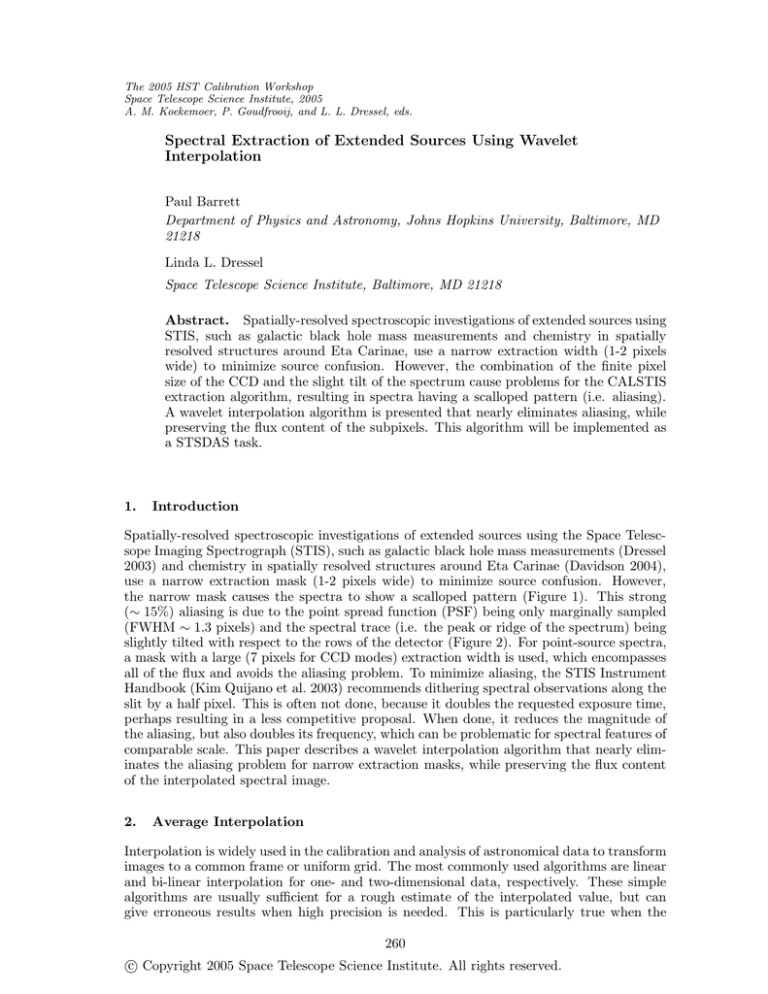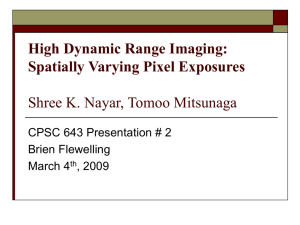
The 2005 HST Calibration Workshop
Space Telescope Science Institute, 2005
A. M. Koekemoer, P. Goudfrooij, and L. L. Dressel, eds.
Spectral Extraction of Extended Sources Using Wavelet
Interpolation
Paul Barrett
Department of Physics and Astronomy, Johns Hopkins University, Baltimore, MD
21218
Linda L. Dressel
Space Telescope Science Institute, Baltimore, MD 21218
Abstract. Spatially-resolved spectroscopic investigations of extended sources using
STIS, such as galactic black hole mass measurements and chemistry in spatially
resolved structures around Eta Carinae, use a narrow extraction width (1-2 pixels
wide) to minimize source confusion. However, the combination of the finite pixel
size of the CCD and the slight tilt of the spectrum cause problems for the CALSTIS
extraction algorithm, resulting in spectra having a scalloped pattern (i.e. aliasing).
A wavelet interpolation algorithm is presented that nearly eliminates aliasing, while
preserving the flux content of the subpixels. This algorithm will be implemented as
a STSDAS task.
1.
Introduction
Spatially-resolved spectroscopic investigations of extended sources using the Space Telescsope Imaging Spectrograph (STIS), such as galactic black hole mass measurements (Dressel
2003) and chemistry in spatially resolved structures around Eta Carinae (Davidson 2004),
use a narrow extraction mask (1-2 pixels wide) to minimize source confusion. However,
the narrow mask causes the spectra to show a scalloped pattern (Figure 1). This strong
(∼ 15%) aliasing is due to the point spread function (PSF) being only marginally sampled
(FWHM ∼ 1.3 pixels) and the spectral trace (i.e. the peak or ridge of the spectrum) being
slightly tilted with respect to the rows of the detector (Figure 2). For point-source spectra,
a mask with a large (7 pixels for CCD modes) extraction width is used, which encompasses
all of the flux and avoids the aliasing problem. To minimize aliasing, the STIS Instrument
Handbook (Kim Quijano et al. 2003) recommends dithering spectral observations along the
slit by a half pixel. This is often not done, because it doubles the requested exposure time,
perhaps resulting in a less competitive proposal. When done, it reduces the magnitude of
the aliasing, but also doubles its frequency, which can be problematic for spectral features of
comparable scale. This paper describes a wavelet interpolation algorithm that nearly eliminates the aliasing problem for narrow extraction masks, while preserving the flux content
of the interpolated spectral image.
2.
Average Interpolation
Interpolation is widely used in the calibration and analysis of astronomical data to transform
images to a common frame or uniform grid. The most commonly used algorithms are linear
and bi-linear interpolation for one- and two-dimensional data, respectively. These simple
algorithms are usually sufficient for a rough estimate of the interpolated value, but can
give erroneous results when high precision is needed. This is particularly true when the
260
c Copyright 2005 Space Telescope Science Institute. All rights reserved.
261
Spectral Extraction of Extended Sources Using Wavelet Interpolation
Lyrae
Figure 1: Extracted STIS G750M spectra of the star β Lyrae (exposure rootname
o5dh01010) using the standard calstis pipeline and various extraction widths as shown
in the legend. The unit of the X axis is CCD pixels, and the Y-axis unit is ADU. The
scalloped pattern, caused by pixel aliasing, is evident in the uninterpolated spectra.
!
!
!
Figure 2: Spectral image of the star whose extracted spectra were shown in Figure 1.
The stairstep pattern or aliasing is due to the slightly tilted spectrum and the marginally
sampled point spread function. The vertical scale is enlarged to show the aliasing.
262
Barrett & Dressel
Figure 3: Left panel: Interpolation of data using a 3rd-order polynomial. The original
values (filled bars) are located at integral values and the interpolated values (open bars)
are at half integral values. Right panel: Average interpolation of data using a 2nd-order
polynomial. The original value (white rectangles) span the integers, and the interpolated
values (gray rectangles) span the half integers.
difference between adjacent data points is large. Better results can be achieved by using
higher (5th or 7th) order polynomials (Figure 3).
Integrating detectors such as CCDs and IR arrays have pixels of finite size. The electrons (or counts) in each pixel are not located at the center of the pixel, but instead are
averaged over the area of the pixel. Interpolation — or what we’ll call point-interpolation
— implicitly assumes that the value is located at a point. Instead the underlying function
f (x) should be average over the area of the pixel:
λ0,k =
Z
k+1
f (x)dx,
k
where λ0,k is the counts in the pixel and k and k + 1 are the boundaries of the pixel (Figure
3). This is average-interpolation and is the most appropriate interpolation for integrating
detectors (see e.g. Sweldens 1997, Donoho 1993).
The difference between point-interpolation and average-interpolation may seem minor,
but the difference can actually be significant, particularly when accurate fluxes are desired.
For astronomical imaging, both interpolation algorithms should give the same total flux
for an isolated point source using a sufficiently large extraction region. However, as the
extraction region decreases, the measured fluxes will begin to differ. The difference can
be > 50% in some cases with the largest difference occurring where the PSF’s gradient is
greatest. The reason for this difference is that the distribution of flux within each pixel is
different for the two algorithms. This problem becomes more acute when the source is no
longer isolated, such as an image of a globular cluster, or the spectrum of an extended source.
In this case, the size of the extraction region is limited, possibly by neighboring sources that
partially overlap the target. An accurate estimate of the total flux in this case requires an
interpolation algorithm that accurately recreates the underlying flux distribution.
3.
Wavelets
Wavelets are usually associated with the compression of signals or images by the application
of an analysis wavelet (forward transform) of a scaling function. The forward transform
uses low and high pass filters to divide the image into smoothed and residual images. The
synthesis wavelet is just the inverse transform. It creates a higher resolution image from a
coarser image.
Spectral Extraction of Extended Sources Using Wavelet Interpolation
263
Multiresolution is the result of the dilation (or refinement) equation:
φ(t) =
N
√ X
2
c(k)φ(2t − k),
k=0
where the scaling function, φ(t), is a continuous function in t and the coefficients c(k) are
discrete in k. This equation relates the scaling function at one scale to the scaling function
of the next finer scaler and shows how to calcluate new coefficients that are half way between
the old ones. In other words, we can reproduce the scaling function φ(t) to any resolution
by recursion of the dilation equation.
Average-interpolation and (iterative) refinement are two key characteristics of our interpolation algorithm. They ensure that the total counts in a pixel are conserved and the
distribution of counts within a subpixel is non-negative. A polynomial is used to approximate the underlying flux distribution. Note that this type of interpolation cannot be done
in a single step, i.e. a pixel cannot be subdivided into eight subpixels in one step. Otherwise, there is the possiblity that some subpixels will have negative values, which is not
physically possible.
4.
Algorithm
The algorithm is a rather simple one-dimensional interpolation problem. The goal is to
improve the spatial resolution along the slit (the cross-dispersion direction) in order to
reduce the effects of aliasing. We are not interested in improving the spectral resolution,
though this is easily achieved by applying this algorithm in the dispersion direction. The
partitioning of the counts within each pixel is done by assuming that a N-th order polynomial
is a reasonable approximation to the local flux distribution. Average interpolation is used
because the CCDs are integrating detectors. Therefore, a polymomial is fit to the cumulative
distribution of N-1 pixels, where N is an even integer. The first point of the polynomial is
zero, since the integrated area is zero, while the last point is the sum of the N-1 pixels. For
each polynomial, only one value, the midpoint of the central pixel, needs to be calculated.
Neville’s algorithm is used to find this value because it is fast and accurate. The counts in
the two subpixels are just the differences between the midpoint value and the points on either
side. The algorithm is then repeated for each subpixel until the desired resolution is reached.
For STIS three iterations, yielding eight subpixels, usually gives sufficient resolution.
The wavelet algorithm does a very good job of reducing the aliasing, though some may
still be present at the few percent level. The aliasing can be reduced further by applying
an optional convolution step to the interpolated image. The kernel that is used is an
approximation of the instrumental PSF and has the form (1 + (x/a)2 )−2 , where a is ≈ 1.3
pixels (see also Martin 2004).
5.
Results
Figure 4 shows the interpolated image with convolution for three iterations or eight subpixels. The image shows very little of the effects of aliasing. The interpolated spectrum
is shown in Figure5 for extraction widths of 1, 2, 4 and 7 pixels. Unlike the uninterpolated spectra, the 1, 2, and 4 pixel width spectra are nearly identical to the 7 pixel width
spectrum: only the flux is reduced by a proportional amount.
Figure 6 shows the PSF or cross-dispersion profile for a point source. The black points
map the pixel-integrated profile, which is created by shifting the spectral trace so it lies
along one row. This causes adjacent pixels in the same row to be shifted slightly with
respect to the others, filling in the gaps. The profile is mostly symmetric with wide wings
264
Barrett & Dressel
Figure 4: Spectral image of star in Figures 1 and 2 after wavelet interpolation and convolution by the instrumental point spread function.
Lyrae
!
Figure 5: Spectra of star in Figure1 after wavelet interpolation and convolution.
265
Spectral Extraction of Extended Sources Using Wavelet Interpolation
Cross dispersion profiles for G750M exposure of
Lyrae
Figure 6: A comparison of the measured pixel-integrated PSF (black points) and the
wavelet-interpolated PSF without (solid line) and with (dashed line) convolution.
on each side and a low shoulder on the left side. For comparison, the solid line is the
profile along a single column from the interpolated image without convolution. Each point
is the sum of eight adjacent subpixels, so that the total area is equal to one pixel as is
the case for the black points. A plot of the individual subpixels produces a line that is
slightly narrower and more peaked than the pixel integrated profile. The solid line follows
the points very closely, except at the peak and near the shoulder. (Note that different
columns have different cross-dispersion profiles, depending on the location of the trace: See
Figure 9 in Dressel et al. 2006.) The dashed line is the profile from an interpolated image
with convolution. This profile is lower and slightly (∼ 15%) broader than the points.
6.
Summary
In most situations, interpolation with convolution is the recommended approach. However
in situations where the highest spatial resolution is required, such as observations of the
binary star WR 140 where the separation of the two stars is about three pixels, interpolation
without convolution is preferred, since convolution broadens the image enough to make
source confusion a problem. In the case of WR 140, a strong emission line in one stellar
spectrum can distort the neighboring spectrum, resulting in incorrect results.
One drawback of this algorithm is that it may become unstable when high order (N> 5)
polynomials are used for more than three iterations. In this situation we recommend using
a lower order polynomial when doing large number of iterations or beginning with a high
order polynomial for the first one or two iterations and then switching to a lower order
polynomial for succeeding iterations.
This paper has not discussed what errors are associated with the interpolated values.
This aspect of the algorithm will be discussed in a forthcoming paper as will the use of
finite impulse response (FIR) wavelet filters on image interpolation or deconvolution.
266
Barrett & Dressel
This algorithm is being added as a post-processing task to the CALSTIS package of
STSDAS. PEB wishes to thank Paul Goudfrooij for useful suggestions and the opportunity
and time to work on this project.
References
Davidson, K. 2004, Technical memo no. 1, Dept. of Astronomy, Univ. of Minnisota, available
through http://etacar.umn.edu/treasury.
Dressel, L. L. 2003, in Active Galactic Nuclei: from Central Engine to Host Galaxy, S. Collin,
F. Combes, & I. Shlosman (San Francisco: Astronomical Society of the Pacific), 393.
Dressel, L. L., Barrett, P. E., Goudfrooij, P., & Hodge, P. E. 2006, this volume, 267
Donoho, D. 1993, Technical Report, Dept. of Statistics, Stanford Univ.
Kim Quijano, J., et al. 2003, “STIS Instrument Handbook”, Version 7.0, (Baltimore:
STScI), 240.
Martin, J. 2004, Technical memo no. 2, Dept. of Astronomy, Univ. of Minnisota, available
through http://etacar.umn.edu/treasury.
Sweldens, W. & Schröeder, P. 1995, SIGGRAPH ’95 Course Notes: Wavelets and their
Applications in Computer Graphics, 3, 76.






